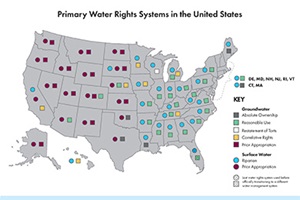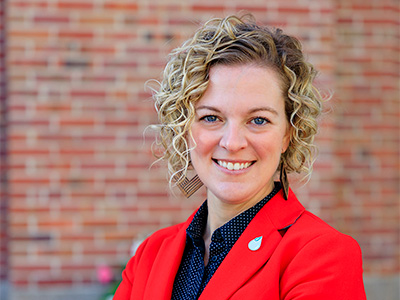LINCOLN, NE – A new thematic map depicting primary water rights systems across the U.S. has been developed by a collaborative team from the Daugherty Water for Food Global Institute (DWFI), the National Drought Mitigation Center (NDMC) and the Department of Agricultural Economics, all at the University of Nebraska. This innovative tool provides a clearer understanding of the variability of surface water and groundwater rights systems, which are crucial for effective water management and policy development by researchers, policymakers and landowners alike.
Water rights systems provide legal boundaries for water management and are essential to understand when developing and evaluating policies and practices around water governance such as water transfers, irrigation limits, interstate water management and drought adaptation.
The map illustrates that western states generally adhere to the prior appropriation system, which prioritizes water rights seniority and is typically independent of land ownership. In contrast, eastern states largely follow common law principles, granting landowners the right to use water that touches their land.
About the Daugherty Water for Food Global Institute at the University of Nebraska
The Daugherty Water for Food Global Institute (DWFI) at the University of Nebraska was founded in 2010 to have a lasting and significant impact on achieving more food security with less pressure on scarce water resources by conducting scientific and policy research; using the research results to inform and advise policymakers; and sharing knowledge through education and communication. DWFI’s vision is for a food and water secure world: one in which global food security is ensured without compromising the use of water to meet other vital human and environmental needs. Learn more at waterforfood.nebraska.edu.
About the National Drought Mitigation Center at the University of Nebraska-Lincoln
The National Drought Mitigation Center (NDMC), established in 1995, helps decision-makers reduce the effects of drought on people, the environment and the economy by anticipating and planning for drought. NDMC collaborates with and learns from decision-makers at all levels – individual ranchers, communities, regions, watersheds, tribes, states, countries – across the U.S. and around the world. Learn more at drought.unl.edu. The center is also the academic partner and web host of the U.S. Drought Monitor, droughtmonitor.unl.edu.
About the University of Nebraska–Lincoln’s Department of Agricultural Economics
Established in 1914, the University of Nebraska–Lincoln’s Department of Agricultural Economics is a vital participant in the thrust of the Institute of Agriculture and Natural Resource, University of Nebraska–Lincoln and the State of Nebraska to develop solutions to the world's agriculture and resource problems. The mission of the department is to improve decision-making by public officials, private producers and agribusinesses by giving them economics information, insights, analytical tools and skills that are not otherwise available. The department’s faculty and staff have expertise that is essential in solving a myriad of issues, from resource allocation to rural development. Through its three undergraduate majors, M.S. and Ph.D. programs, the department educates future leaders in agriculture, economics, business and natural resources.



